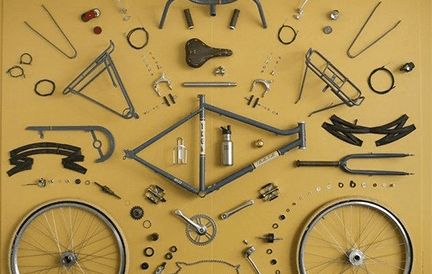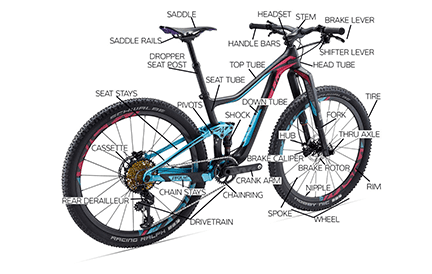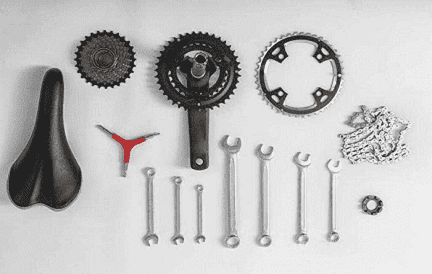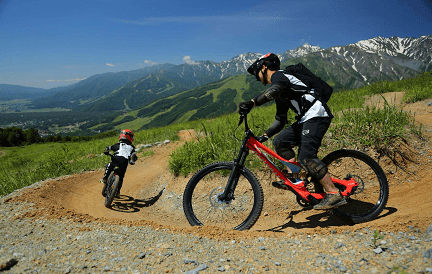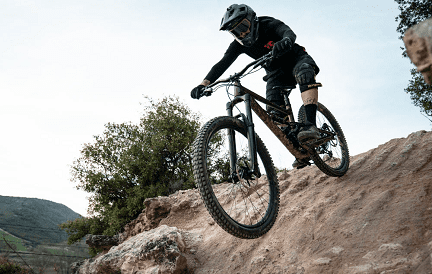Due to their inherent wear and tear, all brake pads are considered “consumable components.” A brake pad MTB that is too old or worn will not function correctly, putting your safety at risk or even causing harm to your bike. Because of this, it is crucial that you keep an eye out for worn brake pads and replace them as necessary.
- Part 1: A Complete Introduction to MountainBike Brake Pads
- Part 2: Classification of Mountain Bike Brake Pads
- Part 3: Advantages and Disadvantages of Different Kinds of Brake Pads MTB
- Part 4: Frequently Asked Questions
- Part 5: Some Words in Conclusion
Part 1: A complete Introduction to MountainBike Brake Pads
One of the key components that allow you to go as fast as you can on the trail is having a really good pair of hydraulic disc brakes on your mountain bike. Slipping into steep and fast terrain without a decent set of brakes makes it far riskier. You should also regularly change your bike’s brake pads, which are an especially important component to maintain.
Understanding the various types of brake pads readily accessible will assist you in making the best decision when purchasing new pads. The distinctions between organic and sintered mountain bike brake pads will be discussed in this article.
When it comes to disc brake pad replacement, the first step is to ensure that you get the appropriate fit for your brakes. There are a bewildering number of various styles to choose from, so don’t expect all brands’ brakes to use the same pad. For example, depending on the year of manufacture, Shimano XT brake pads come in a variety of styles.
This is a good place, to begin with if you know the precise model and year of your brakes, but the best way to determine if the current ones will work perfectly is to remove the old ones and visually make a comparison between them; even if they are beyond repair, you will have to replace them, so it is not a huge issue.
Removal of Brake Pad MTB
Detach the wheel before cleaning the calliper with disc brake cleaner and wiping it clean with a clean rag or tissue. You will need to re-insert the pistons because worn pads are thinner as compared to the new ones, and hydraulic systems force them out to compensate. If you forgo this step, you will have trouble reinstalling the disc and wheel with the new pads. There are various instruments for forcing pads back, and some multitools will include one as well, but a huge, flat-bladed screwdriver or tire lever used cautiously will accomplish the same task. Place it in between the pads where the disc would normally sit and softly pull them back until they can no longer go any further.
Depending on the model, you will have to tweak cable tension or a pad advance adjuster on cable systems. When it comes to disc brake pads, a pin that passes through both pads and has a retention clip on one end holds them in place most of the time. Remove that before unscrewing or removing the pin. Make sure you do not lose these because aftermarket pads frequently do not come with them.
Inspection of the Brake Pad MTB
Now that you have taken out the brake pads, it is a good time to look over them; There are a number of things that might cause your calliper to be out of sync, including excessive wear on one side of the pad and an oily piston.
Both of these considerations must be taken into account prior to purchasing new pads. Assume they have worn all the way down to the metal backing pad. In that scenario, inspect your rotor for scoring damage, and if they have worn through the backing pad as well, it is shameful that you did not notice it before.
It’s also a good idea to check the pistons for damage. Verify that the rotor is not too thin if you have gone through a number of pads on the same rotor. Check the company’s minimum thickness requirements.

Part 2: Classification of Mountain Bike Brake Pads
To make a solid block on the backing pad, a variety of powdered additives are mixed with a binding agent. The contents of the powder mix have a significant impact on the pad’s characteristics.
For bikes, there are three different types of disc brake pad compounds:
Organic Brake Pads
Organic brake pads are made out of a resin-bound mix of fibres. Kevlar, carbon, and rubber are all possible materials for organic brake pads.
Organic brake pads are often softer than sintered brake pads, making them quieter. Organic brake pads will give you an extra beginning bite when you first hold the brake lever on a mountain bike. One of the few drawbacks of organic brake pads is that they do not handle heat well enough and fade more quickly on longer slopes. Long descents are when you need to rely on your brakes the most, and heat-soaked organic pads may lose some energy.
Organic brake pads’ most significant disadvantage is that they perform very poorly in wet conditions. In damp and grimy conditions, the brake pads can wear down even faster, and they can also become glazed over, preventing them from performing in dry conditions.
Sintered Brake Pads
This kind of braking system is known as a metal-sintered or metallic braking system because it is made of metal particles melted together at high temperatures and pressure.
This versatility has made sintered brake pad implementations commonplace across a broad spectrum of vehicle types, including mountain bikes and motorcycles.
In wet and muddy trail conditions, sintered brake pads will continue to grip as firmly as ever. Sintered brake pads may perform much better in racing situations because they are less affected by heat build-up.
The more weight you put on your brakes; the greater the amount of heat is. On the long, steep descents, sintered brake pads will not fade as quickly as organic brake pads.
There are a few drawbacks to using sintered brake pads. One of them is that they can make a lot of noise. Depending on how wet or hot the brake pads are, they might make a very high-pitched noise. Sintered pads are also more difficult for rotors to handle because of their solid nature. It is not an issue for most riders since steaming up brake rotors takes a lot of abuse.
Semi-Metallic Brake Pads
As the name implies, metallic fillers are mixed with organic fillers to achieve stability of attributes. They are a wonderful alternative to sintered pads for those who want greater toughness over organic pads. On the other hand, they each retain some disadvantages as well.
Comparison Between Finned and Standard Backing Plates
Some of the brake pads we featured have “finned” backing plates, as you may have noticed from the list. Some manufacturers include this feature in their pads to aid in more efficient heat dissipation. This function will have no impact on most recreational riders, and the often cheaper non-finned pads will suffice. Downhill and enduro racers will appreciate the
Unless you are not sure what brake pads to get for your bike, sintered or metallic pads are pretty much the best option. They provide a strong, steady ride in all riding situations and are suitable for a wide range of implementations. Organic brake pads are fairly quiet and have a better initial grip, but they fade faster on long descents and have less power in damp environments.
When you replace the brake pads on your mountain bike, you should also repair and bleed the entire brake system. Your brakes will feel completely new once more after bleeding them and replacing the pads.
Part 3: Advantages and Disadvantages of different kinds of Brake Pads MTB
Regardless of the cost, having the best brake pads for your bike and the type of riding is essential. Each type of brake pad has its own set of benefits and drawbacks. Talk to your repair shop about what kind of brake pads MTB they’d suggest for your bike.
Organic Brake Pads
Because of its excellent heat resistance and long life, asbestos was once a common component of traditional brake pads. After it was discovered that asbestos dust was harmful to one’s health, a non-metallic, organic variant was created. These brake pads are affordable and gentle on the rotors. These pads will usually work well if you ride almost every day. They may not be as effective if you ride in odd situations, like hauling or mountain biking in hot weather.
Semi-metallic Brake Pads
These brake pads are somewhat more expensive than organic brake pads, but they last far longer. They are not as gentle on the rotors as organic brake pads and might score them if not changed soon. These brake pads excel in cold and hot weather, light-to-medium towing, and mountainous terrain. Their downsides include being louder than the other two kinds of pads and producing more dust.
Part 4: Frequently Asked Questions
Q: How to Ensure MTB Brake Pads Compatibility with Brakes
Aside from the varied compounds, disc brake callipers only accept pads designated for them, which come in a range of forms and sizes. For replacement components, search for comparable information from the braking system or aftermarket pad manufacturer.
Q: What is the Right Time to Replace Your Brake Pad MTB
Disc brake pads are one of the bike’s consumable components. It’s vital to keep brake pads and other components in top shape and to repair them as needed. When braking output deteriorates and other problems have been eliminated, brake pads should be upgraded.
Metal-on-metal contact may harm rotors, so replacing brake pads before they wear down to the backing material is critical. Visual examination is the simplest way to tell whether they need replacing.
Q: How to Replace the Brake Pad MTB
Needle-nose pliers, hex keys, big flathead screwdrivers, or pad pusher tools are all necessary to clean braking system components. Always take your bike to a local bike shop to replace the brake pads.
Part 5: Some Words in Conclusion
A well-functioning mountain bike disc brake system relies heavily on brake pads. This will ensure that you have reliable braking performance on even the most difficult terrain rides.


